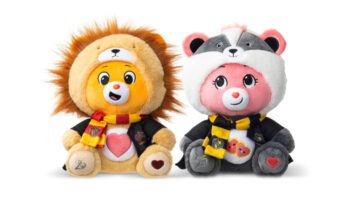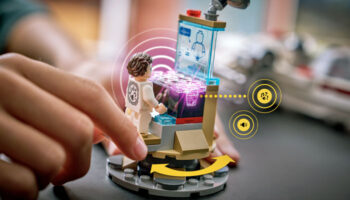Cerim Manovi – Design Director for LEGO DREAMZzz – on the origins of LEGO’s latest homegrown IP

Cerim, it’s great to catch up. To kick us off, where did the idea for this new LEGO DREAMZzz theme stem from?
We wanted to create a new homegrown LEGO IP, and we wanted to nail down the story and concept first before embarking on any toy development. We also wanted to create a theme that was inclusive and carried the LEGO brand’s core values of creativity and imagination.
The next step was to put some creative heads together. We had writers, designers and marketeers working together – and we had several ideas that we exposed kids to. The one that we felt was hitting the target was centred on the idea of ‘What if the dream world came alive?’
We used very simple concept art with the kids, but it resonated and answered all our criteria. We created a visual of two kids standing on an island looking out at all these different dream islands. That was the spark… It was wild, crazy, adventurous and we knew we had something.
With certain themes, you have established beats to hit… With Pirates, there’s going to be ships and treasure. With NINJAGO, there’s ninjas and swords. With LEGO DREAMZzz, I’d imagine anything was on the table! Did that make things more challenging? Would some constraints have been useful?
I worked for four years on NINJAGO and you’re right, there’s a clear set of icons to play with – ninjas, swords, dragons, martial arts. With DREAMZzz, the possibilities are infinite, but we’ve tried to define a dream logic.
We’ve done a lot of reading on dream science and dream interpretation, and we found that dreams and creativity work in a similar way. With both processes, you take everything you know – consciously and unconsciously – and mix them together to create something unfamiliar.
A good example of this kind of ‘mash-up DNA’ is Mr Oz’s Spacebus. We had an idea that Oz gets a cool rocket. It was a 1920s-inspired rocket. We showed this to the kids and they said: “it’s a cool rocket, but what does it do in the dream world?” It wasn’t fantastical enough so the mash-up came into play with the bus.

When you think about it, we’ve been doing mash-ups for thousands of years. Look at Pegasus, it’s a horse with wings. So why can’t we bring a turtle and a caravan together! Mash-ups was our frame-set and our canvas became whatever kids love; combinations that were familiar and iconic, but also wild and interesting.
How close was the collaboration between the toy designers and the team working on the LEGO DREAMZzz TV show?
I’d have nightly calls with the team in LA two or three times a week, but now we do it every Monday because we’re in the delivery phase. It’s all about trust and accountability. The story people are story people, and they’re really good. When I talk to Tommy Andreasen, the showrunner, he always jokes that I’m a storyteller because understanding how a story works ultimately makes my job as a toy developer easier. It goes hand-in-hand. Even though we work on separate sides, we try to work as a unit.
We’ll have ideas on the product side for things like how a character looks and what their powers are and we’ll pitch those to the writing team. It’s a very organic process and we have a lot of mutual respect for our professions.
Whenever we speak with designers at the LEGO Group, there’s always some nice examples of LEGO elements being used in different ways to resemble different things… A banana in one set might be an eyebrow in another! Do any come to mind from the LEGO DREAMZzz sets?
Our designers are so clever in utilising the shapes differently. Sometimes it’s also a signature move. One example from LEGO DREAMZzz is Z-Blob. If you look at his dome head, it’s a very basic, simple element. It’s been around for years and years and years. We took it, printed eyes on it and BOOM! We had Z-Blob.
We could’ve gone out and created a sophisticated bubbly-shaped head for that specific build but it’s that dome element is so truly LEGO. It’s been lots of different things before, but now it’s his head! It’s key to his identity.

What dictates when the LEGO Group decides to launch a new theme?
We have different themes that cater to different user groups, and there is always a need and an ask from kids wanting to see something new from us. We don’t have a ‘quota’ of homegrown IPs that we need, but we don’t want our homegrown IPs to clash or crossover too much.
The first one from years ago to launch alongside mini-content was, I think, LEGO Atlantis or LEGO Power Miners… Then NINJAGO hit and it went BOOM! It worked really well and we continued to flex this muscle with LEGO Nexo Knights and LEGO Chima. LEGO Hidden Side was a different type of idea because it was a showcase for innovation around physical/digital play, but LEGO DREAMZzz is another story-first, creativity driven homegrown IP.

You mentioned about the success of NINJAGO there. How powerful are these homegrown brands when it comes LEGO’s internal plans? Can they shape where you go?
They do, and they give us a playground to experiment, which is important. It’s not just money that makes one of these brands a success. We learn a lot from each one and we implement these lessons further down the line.
When we launched NINJAGO, we discovered there was an appetite and a love for LEGO themes that have characters, stories and animation. And I’m sure previous launches, like LEGO Time Cruisers, would’ve inspired some element of what went onto make NINJAGO successful. These launches give us a frame of experience that we can utilise when you next create new things.
Great answer. Before we wrap up, you’ve worked on lots of different sets in your time at the LEGO Group. What do you think is the most underrated set you were involved with?
The first thing that comes to mind are the LEGO NINJAGO Dungeons of Shintaro sets we did. We added a tabletop role-playing game into these sets. It was a cool set with a lot of details that had this added layer to it with the game. I think it’s underrated because people didn’t grasp the game concept directly and we didn’t really market that aspect of it. I thought it was a really cool, beautiful concept.

Interesting pick! Final question – how do you fuel your creativity?
I play Zelda, I watch TV shows, I read comics, I go on walks, I talk to my kids… You’ve got to walk through life with open eyes.
And if you’re working in such a fantastic environment, with fantastic people, it’s inspiring. My team has a weekly meeting – we call it the Dreamers Club – where everybody shows the team something they’ve discovered. It’s great for inspiration.
We have people from all over the world and they bring their interests and passions. It’s that hive of creativity and backgrounds that makes the LEGO Group unique. This summer I’m going to South Africa and I’m sure I’ll bring a lot of that back into work in some way. Inspiration is everywhere.
Cerim, thanks again – and congrats on the launch of LEGO DREAMZzz.
–
To stay in the loop with the latest news, interviews and features from the world of toy and game design, sign up to our weekly newsletter here





















